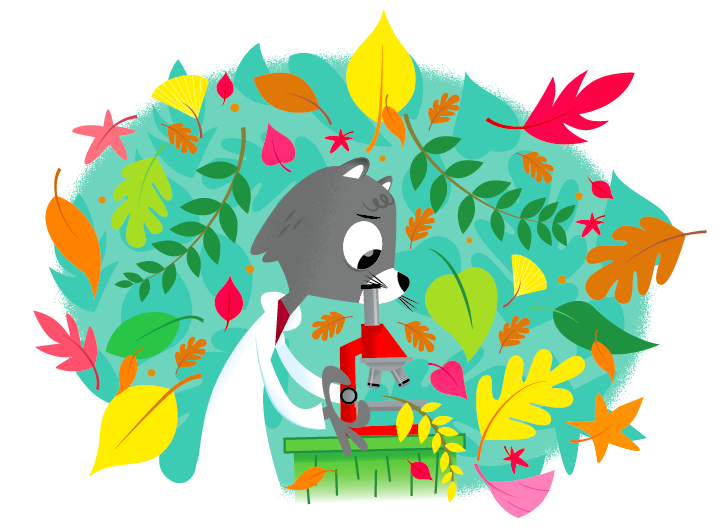Dear Lucy,
Ever since I was a kitten, I’ve loved picking up big maple leaves in the fall. I’d take them home, put them under a piece of paper, and rub the side of a crayon over the top. It makes a great print of the leaf.
Leaves actually get their color from things called pigments. While scientists can use chemicals to make different crayon colors, nature can use pigments to create its own colors.
When leaves are green, they have a pigment called chlorophyll. Chlorophyll is not just important for color, though. Plants also need chlorophyll to collect energy from the sun to make their own food. Imagine if you could soak up sunshine, water, and stuff from the air to make your own food. That’s what plants do. They make their own food in a process we call photosynthesis.
My friend Asaph Cousins is a scientist at Washington State University who knows a lot about how plants function. He’s really curious about photosynthesis, too.
“It’s a remarkable process that helps convert energy from the sun into food for plants,” he said. “It’s a key part of life on our planet.”
Cousins explained that chlorophyll has the job of soaking in the sunlight and using energy to convert some gas from the air into sugars. In the spring and summer, when the sun is out, a plant needs to make a lot of chlorophyll to help create food. But in some places of the world, like here in the Pacific Northwest, the sun starts to set earlier and it gets colder in fall.
As we pull out our scarves and mittens, trees get ready for the changing season in their own way. Their growth decreases and they start to store up some of that energy they made earlier in the year. This means photosynthesis slows down and they don’t need as much chlorophyll to make food. Photosynthesis slows and the chlorophyll inside the leaves breaks down—so we see less green before the leaves fall off.
Chlorophyll isn’t the only pigment in a leaf. There are also carotenoids, which are pigments that give fall leaves the yellow and orange colors we see. It’s the same pigment we find in sunflowers and carrots, too. You may remember from our question about apples, that the pigment called anthocyanin is responsible for the red color in the fruit. The same is true with red leaves.
Because there is so much chlorophyll in the leaf, it isn’t until the chlorophyll breaks down that the fall colors really start to pop out. Of course, not all trees lose their leaves in fall and grow new ones back in the spring. But the ones that do lose their leaves—the ones we call deciduous trees—can transform their colors in just a matter of weeks.
Once the leaves finally fall to the ground they make for some great piles to jump in, inspiration for art projects, and beautiful autumn scenes.
Sincerely,
Dr. Universe
Try it out! What can you create with leaves? Send a pic of your own fall leaf project to Dr.Universe@wsu.edu.
